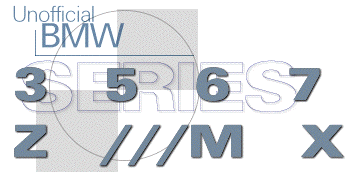|
Ron Stygar Carl Buckland Dale Beuning Forums Help
FromDate: Tue, 6 Jun 2000 10:19:08 +0100
From: "Hunter Johnson" <HJOHNSON_at_dbmail.debis.de>
Jim E says: "For some unknown reason (at least to me) the ZKW were never used on the M3 coupe - neither the 3.0 or 3.2." Jim B says: "Would the coupe lights be different than the sedan? Just wondering, since the Euro lights I have on my car are ZKW (purchased from Bekkers Imports, IIRC)." Jason says: "I saw some strange lights on Kelly wollenbergs car once. Looked like US headlights, but were glass. She ordered them when she did euro delivery. So they arre US dot glass lights. maybe you got one of those..." The early Euro E36s came with polyellipsoidal low beams, which were replaced 5 years ago with what Jason calls "looked like US headlights but were glass". The polyellipsoid system works like an overhead projector, with the bulb at the first focus of the ellipse and the screen which produces the sharp horizontal cutoff positioned so that the funky semi-spherical lens projects it onto the road. The "poly" part of the polyellipse means that the reflector shape is two different ellipses, one shape for the vertical cross section, another for the horizontal cross section. This way a lot of light is dispersed from right to left, but not so much dispersal happens from top to bottom. The newer headlamps are Free Form (Hella's term) which means that a computer is used to calculate the shape of the reflector given the bulb position and the desired beam pattern on the road. This technology was used on ALL US E36s, although of course the ECE and DOT beam patterns are different, so these units are different. FF lamps are much more efficient than the polyellipsoid system (if there is a screen, then some of the light is hitting the screen and not getting to the road), although personally I prefer the Polyellipsoid since it focuses the light more intensely. On all E36 headlamps the high beams are probably simple parabolas. One of the other differences between DOT and ECE lamps is the use of glass vs. polycarbonite for the outer lens. The DOT has strict rules about the watertightness of the headlamp assembly, and the ECE lamps often fog up from poor sealing. However, the DOT lamps' plastic also get sandblasted after several years of use and this messes up the ability of the light to get out, requiring replacement of the entire headlamp to return to 100% performance. The ECE unit's glass outer lens can be replaced for around $60.
The difference between a Bosch, Hella or ZKW headlamp unit designed for the E36
is probably nonexistent, although these suppliers will probably tell you
otherwise.
Personally I believe that while there is still a difference between the BMW ECE
and
That said, please keep in mind that a properly aimed ECE lamp (1% drop) has a
range of
However, I find that the ECE high beams are superior to the DOT highbeams, even
though
John F. will surely want to comment on all this, since both of us live in
Germany,
If that doesn't do it for you, then try the ECE lamps, but I would go the extra
mile and
Hunter |

